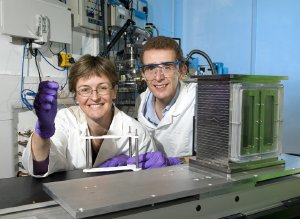Nov 29 2009
A new discovery about nanoparticle behaviour in sewage treatment plants could improve the environmental management of nanoparticle wastes from foods, cosmetics, medicines, cleaners and personal care products.
 Steve and Helen preparing the sewage sample for the experiment using the ISIS Neutron Source
Steve and Helen preparing the sewage sample for the experiment using the ISIS Neutron Source
Steve and Helen preparing the sewage sample for the experiment using the ISIS Neutron SourceScientists from the Centre for Ecology & Hydrology (CEH) and the Science and Technology Facilities Council’s ISIS Neutron Source, along with colleagues from King’s College London and Oxford University, have studied how certain nanoparticles behave in wastewater and identified a way to potentially help remove them during primary sewage treatment. The scientists examined silica nanoparticles which are commonly found in consumer products and routinely discharged to wastewater.
The study, published in Environmental Science and Technology, simulated primary sewage treatment to show that coating silica nanoparticles with a detergent-like material (surfactant) made the nanoparticles interact with components of the sewage to form a solid sludge. This sludge can be separated from the wastewater and disposed of. In contrast, uncoated nanoparticles stayed dispersed in the wastewater and were therefore likely to continue through the effluent stream.
Each year manufacturers worldwide use over one million tonnes of silica nanoparticles in consumer products. A large proportion of these are washed down the drain into the sewage system. This makes sewage treatment plants a major gateway for nanoparticles to enter the aquatic environment.
“Our research shows that primary sewage treatment may not be effective at removing some nanoparticles. However, we now know where those nanoparticles may go and how we might deal with them,” said Dr Steve King from the ISIS Neutron Source.
A cartoon drawing depicting the experimental resultsThe scientists used the ISIS Neutron Source to view the sewage at the nanometre scale. Nanoparticles are too small to be seen by the human eye. The ISIS Neutron Source is like a giant microscope, enabling scientists to study objects 1,000 times thinner than a human hair.
The neutrons easily penetrate the turbid sewage and scatter strongly from the nanoparticles, allowing the aggregation behaviour of the nanoparticles to be measured through time.
Dr Helen Jarvie from the Centre for Ecology & Hydrology said, “The research proves that the surface chemistry of nanoparticles influences their likely removal during primary sewage treatment. By adding a coating which modifies that surface chemistry, it may be possible to re-route their journey through sewage treatment plants.” She added, “Further work is now planned to examine the behaviour of a wider range of nanoparticles, with different classes of surfactants, in wastewaters